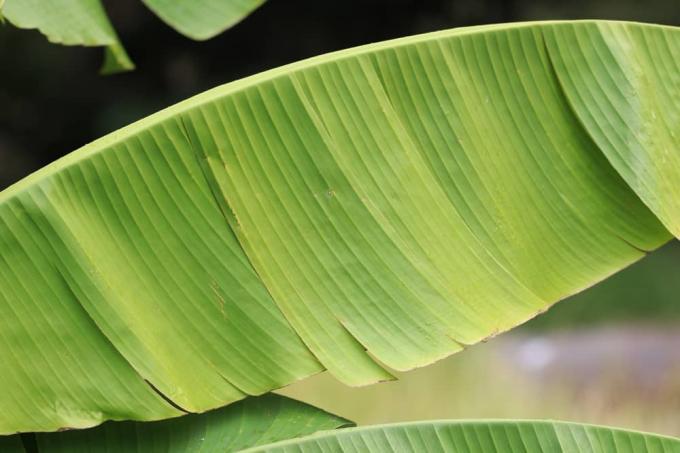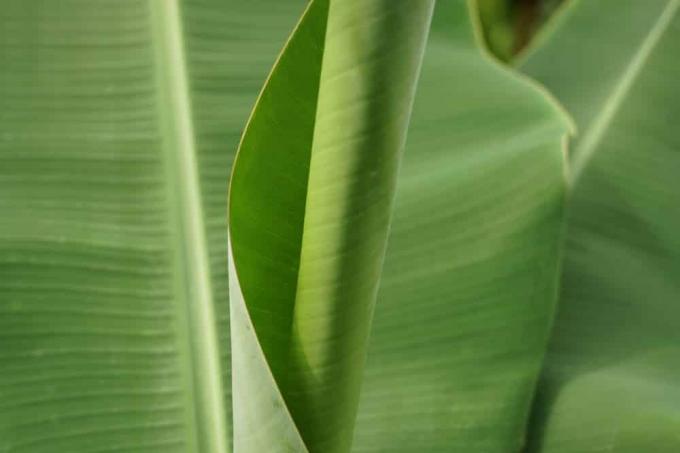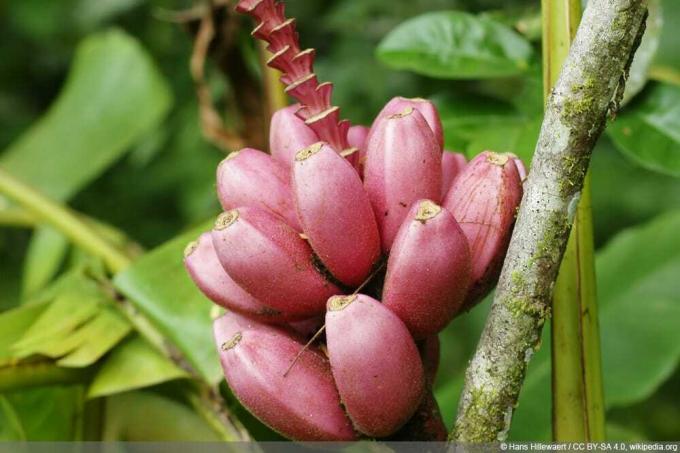

Table of contents
- Characteristics
- Location
- propagation
- Cultivation from seeds
- Propagating by offshoots
- substrate
- repot
- Pour
- Fertilize
- Overwinter as container plants
- Hibernation outdoors
- pruning
- Support
- pests
- care mistakes
The pink dwarf banana is also known as the Kenya banana or velvet banana. It is enjoying increasing popularity among hobby gardeners. In summer, it delights with its beautiful exotic flowers. Even in our latitudes, the small banana plant produces sweet, aromatic fruits. We have put together the most important care tips for you so that it can also develop well on your terrace or in your garden.
Characteristics
- Growth height: one to two meters
- Plant family: Banana family (Musaceae)
- Origin: Africa and Asia
- Flowers: yellow center surrounded by slender, pink to pink colored bracts
- Flowering time: Summer, flowers form as early as two to three-year-old plants
- Harvest time: late summer to autumn
- Location: outdoors from April, sunny to semi-shady, sheltered from the wind
- Fruits: pink mini bananas, edible, tasty, covered with downy hair
- Flowers: very decorative, yellow center, bracts pink to pink
- Use: container plant, house plant, garden plant
Location
Native to the tropical regions of Africa and Asia, the pink dwarf banana needs a warm, sunny, wind-protected location. Direct sunlight should be avoided, especially for young plants. The Musa velutina is ideal as a container plant and can be cultivated on the terrace, on the balcony or in the conservatory. The small banana also thrives outdoors. However, it is not winter hardy. With reliable winter protection, the decorative plant can also spend the winter outdoors in our latitudes.
propagation
Anyone who is once amazed by the beauty of the plant will try to grow the plant from seeds themselves. Growing your own is a real adventure.
Cultivation from seeds

Banana seeds are very hard and require special treatment to germinate.
- Rough up the tough seeds with sandpaper
- Soak in lukewarm water for 12 to 24 hours
- Fill the seed tray with potting soil or coconut fibre
- cover with a glass plate or foil, air from time to time
- insert soaked seeds, cover with some soil
- place in a warm place (approx. 25 degrees Celsius)
- Germination after two to three weeks
- carefully transplant small plants into pots with a layer of gravel and nutrient-rich soil
- water sufficiently, absolutely avoid waterlogging
Tip:
The use of coconut fiber has proven itself for growing Kenyan bananas from seeds. This is permeable to air and low in nutrients and meets the requirements of the plant very well.
Use of germ bags
Experts recommend cultivating in a germ bag for propagating the Kenyan banana from seeds. After soaking, place four to five banana seeds on a damp cotton pad about three inches in diameter.
Cover the seeds with a thin layer of cotton wool. Now put the germination pad with the seeds in a sealable plastic bag. The cotton wool must be damp, it must not be wet. Place the germination bag in a place with a temperature of around 25 degrees. As soon as the seedlings are visible, place them in pots with potting soil.
Propagating by offshoots
If your pink dwarf banana has developed well, it will produce more and more offshoots, so-called kindles. You can grow new plants from these as soon as they have formed at least five leaves.
- Remove the banana plant from the bucket
- Remove soil from roots
- Break off branches vigorously
- Place offshoots in water glasses until roots form
- plant in pots with nutrient-rich soil
- water regularly after two days without watering
substrate
The Kenyan banana thrives in tubs and pots in humus-rich soil. It is recommended to mix these with gravel to achieve good permeability.
Outdoors, the plant needs loose, permeable, nutrient-rich soil, which is enriched with compost in spring.
repot

The pink dwarf banana grows very quickly. It forms an extensive root system. It is important to regularly repot potted plants into larger pots with sufficient substrate.
Pour
The Musa velutina needs sufficient moisture. It grows very quickly and has a high water consumption. With potted plants, care must be taken to ensure that no waterlogging can form. Waterlogging can cause the fleshy roots to rot and the plant to die. In the garden, the small banana should be watered extensively every three days during the summer months.
Fertilize
In the field, Kenyan bananas thrive when provided with nutrient-rich compost soil in the spring and fertilized with an organic fertilizer every one to two months until the fall. In the tub, weekly fertilization with a complete fertilizer is required from spring to autumn. Fertilizer sticks are a good alternative.
Tip:
If your plant falters or its leaves turn yellow, stop feeding for a week or two.
Overwinter as container plants
The pink dwarf banana is not hardy. As a container plant, it needs a sheltered location with a room temperature of at least 8 degrees Celsius in winter. At the same time, she needs sun. Choose a location that is as sunny as possible for your plant in the conservatory or on the veranda. A high level of humidity is necessary for the banana even in winter. You can achieve this by spraying with a water spray bottle every day. Use stale, low-lime water. Ensure even moisture in the pot.
Tip:
The Kenyan banana is very sensitive to heating air. Under no circumstances should it hibernate near a heater.
Hibernation outdoors
Outdoor bananas can also overwinter outside with special protection.
- Remove all leaves before the onset of the first frost.
- Cut back the banana plant vigorously.
- Pile up the trunk with dirt and brushwood.
- Form a circle of rabbit wire about a meter in diameter around the plant.
- Fill this loosely with autumn leaves or straw.
- Cover this cylinder with foil, coconut or raffia mats.
- Make sure that no water can accumulate inside the cylinder.
- Be sure to leave the sides open so as not to impede airflow.
Tip:
Alternatively, you can use small or Cover plants that have been severely cut back with brushwood and leaves and put a wooden box over them.
pruning
Potted plants that have grown too large should be cut back to about 30 centimeters after the winter rest. Cut the trunk horizontally. New shoots form from the center. Banana trees that hibernate outdoors are cut back vigorously before wrapping them in straw, brushwood, leaves or jute. It is enough to leave 20-30 centimeters. Always remove all leaves before hibernation, as they would die anyway.
Support

The dwarf banana forms large, heavy leaves. Make sure that the plant does not collapse under the weight of the leaves. Supports made of bamboo sticks have proven their worth. Tie three sticks together at the top and use them to carefully support the leaves without damaging them. You can buy the rods in different sizes in the hardware store or in the garden shop.
Tip:
Regularly remove the withered leaves of the dwarf banana, which unnecessarily burden the plant.
pests
spider mites
The pink dwarf banana is often attacked by spider mites, especially during hibernation. You can recognize the infestation by whitish webs in the area of the leaves. Make sure that potted and tub plants have sufficient humidity, even in winter, to protect them from pest infestation.
Mealybug
If the dwarf banana is too cold in winter, it will quickly become infested with mealybugs. The first visible signs are a yellowing of the leaves and cotton-like, white webs all over the plant. Oil-based agents to combat the pests are commercially available.
care mistakes
Brown, wilted leaves: Mistakes in care, such as too little light or too little water, are often reflected in the leaves turning brown and falling off. Remove the affected leaves and ensure a good location and sufficient moisture.
 garden editorial
garden editorial I write about everything that interests me in my garden.
Learn more about potted plants

Abalie, Abelia grandiflora: 14 tips for proper care
The large-flowered abalia (Abelia grandiflora) is an extraordinarily easy-care ornamental shrub that delights with numerous funnel-shaped and subtly scented flowers. It is just as suitable as a background plant as a hedge or container plant.

Caring for the tangerine tree properly | 13 tips for the tangerine tree
Many citrus plants have evolved from the tangerine, one of the oldest and most original citrus species. With its white flowers and orange fruits, it is a feast for the eyes and the palate. In this country it is only cultivated as a container plant due to its sensitivity to frost.

Indian canna, Canna indica | 13 tips for care
Canna indica, also known by the botanical name Canna indica, is a decorative plant that not only enriches every garden during flowering. In pot culture, it can be used as an accent for many years thanks to its color and growth.

11 absolutely hardy container plants
Absolutely hardy potted plants have several advantages to offer, because they can remain outdoors even when the temperature is below zero and require little protection. If they are also evergreen, they can also bring joy all year round.

Is dwarf bamboo hardy? | 11 tips for care & cutting
Dwarf bamboo is one of the easy-care sweet grasses. In the garden, it can be used as a good ground cover, as it does not grow as tall as its larger relatives. Whether the plant is hardy and how it is cared for and cut can be read in the guide.

Fig tree, Ficus carica: Care from A-Z | 4 tips for growth
The fig is one of the oldest cultivated plants, as its sugary fruits were used as a sweetener in the past. The fig tree comes from Asia Minor, but can also be cultivated in this country. The advantage is that the fig is easy to care for.
